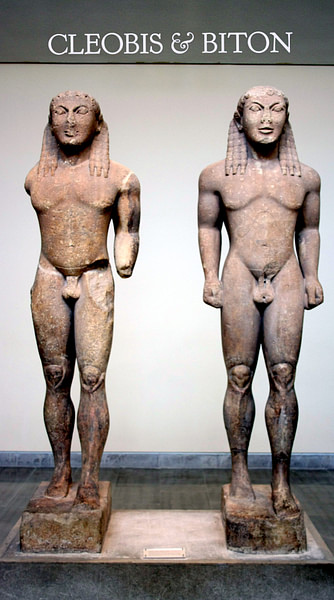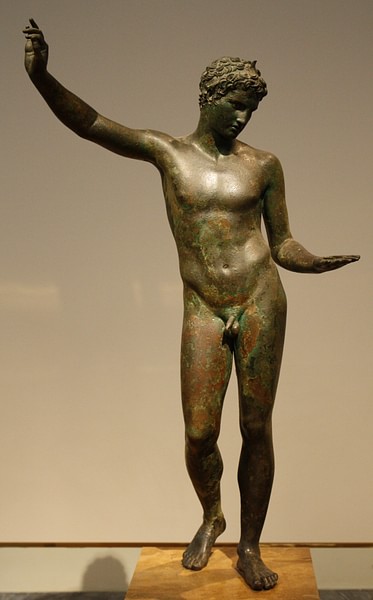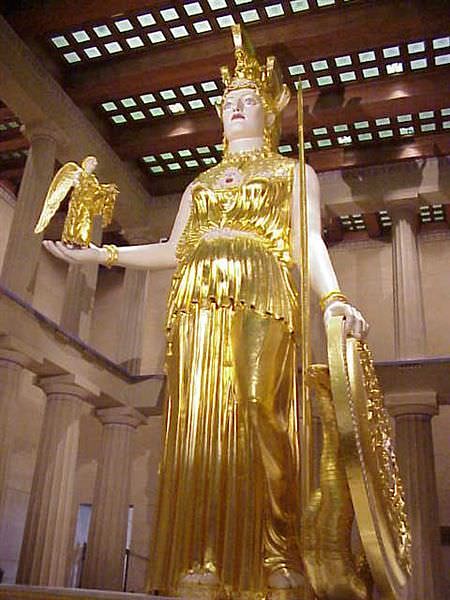2012 Greek Art and Archaeology a New History C 2500ã¢â“c 150 Bce Free
The sculpture of ancient Hellenic republic from 800 to 300 BCE took inspiration from Egyptian and Near Eastern monumental art, and evolved into a uniquely Greek vision of the fine art form. Greek artists captured the homo form in a mode never before seen where sculptors were specially concerned with proportion, poise, and the idealised perfection of the human body.
Greek sculptural figures in stone and bronze take become some of the most recognisable pieces of art ever produced past any civilisation and the Greek artistic vision of the human form was much copied in antiquity and has been ever since.
Influences & Evolution
From the 8th century BCE, Archaic Hellenic republic saw a rise in the production of small-scale solid figures in clay, ivory, and bronze. No doubt, wood too was a ordinarily used medium merely its susceptibility to erosion has meant few examples have survived. Bronze figures, human heads and, in detail, griffins were used as attachments to statuary vessels such as cauldrons. In fashion, the man figures resemble those in contemporary Geometric pottery designs, having elongated limbs and a triangular torso. Animal figures were as well produced in large numbers, especially the horse, and many have been found across Greece at sanctuary sites such every bit Olympia and Delphi, indicating their common function every bit votive offerings.
The oldest Greek stone sculptures (of limestone) engagement from the mid-7th century BCE and were constitute at Thera. In this period, bronze free-standing figures with their own base of operations became more common, and more ambitious subjects were attempted such as warriors, charioteers, and musicians. Marble sculpture appears from the early 6th century BCE and the first monumental, life-size statues began to be produced. These had a commemorative role, either offered at sanctuaries in symbolic service to the gods or used as grave markers.
The primeval big stone figures (kouroi - nude male youths and kore - clothed female person figures) were rigid as in Egyptian monumental statues with the arms held straight at the sides, the feet are almost together and the optics stare blankly alee without any item facial expression. These rather static figures slowly evolved though and with ever greater details added to pilus and muscles, the figures began to come to life.

Cleobis & Biton
Slowly, arms go slightly bent giving them muscular tension and one leg (ordinarily the right) is placed slightly more than forrard, giving a sense of dynamic movement to the statue. Excellent examples of this mode of effigy are the kouroi of Argos, defended at Delphi (c. 580 BCE). Around 480 BCE, the concluding kouroi become ever more life-like, the weight is carried on the left leg, the right hip is lower, the buttocks and shoulders more relaxed, the head is not quite and so rigid, and in that location is a hint of a grin. Female kore followed a like development, particularly in the sculpting of their dress which were rendered in an ever-more realistic and complex way. A more natural proportion of the figure was too established where the head became one:7 with the body, irrespective of the actual size of the statue. By 500 BCE Greek sculptors were finally breaking abroad from the rigid rules of Primitive conceptual art and beginning to reproduce what they actually observed in real life.
Sculptors strived to make the slice seem carved from the inside rather than categorical from the outside.
In the Classical flow, Greek sculptors would pause off the shackles of convention and achieve what no-one else had ever earlier attempted. They created life-size and life-similar sculpture which glorified the human and peculiarly nude male form. Even more was accomplished than this though. Marble turned out to exist a wonderful medium for rendering what all sculptors strive for: that is to brand the piece seem carved from the within rather than chiselled from the outside. Figures get sensuous and appear frozen in activity; information technology seems that only a 2nd ago they were actually alive. Faces are given more expression and whole figures strike a particular mood. Clothes also become more than subtle in their rendering and cling to the contours of the body in what has been described as 'wind-blown' or the 'wet-wait'. Quite simply, the sculptures no longer seemed to be sculptures simply were figures instilled with life and verve.
Materials & Methods
To meet how such realism was achieved we must return again to the offset and examine more closely the materials and tools at the disposal of the artist and the techniques employed to transform raw materials into art.
Early Greek sculpture was most oftentimes in bronze and porous limestone, but whilst bronze seems never to have gone out of fashion, the stone of choice would become marble. The best was from Naxos - close-grained and sparkling, Parian (from Paros) - with a rougher grain and more translucent, and Pentelic (most Athens) - more opaque and which turned a soft honey color with age (due to its iron content). Notwithstanding, stone was chosen for its workability rather than its ornament equally the majority of Greek sculpture was not polished but painted, often rather garishly for modern tastes.

Gigantomachy, Treasury of the Siphians, Delphi
Marble was quarried using bow drills and wooden wedges soaked in water to break away workable blocks. Generally, larger figures were not produced from a single slice of marble, but important additions such as arms were sculpted separately and fixed to the principal body with dowels. Using iron tools, the sculptor would piece of work the block from all directions (perhaps with an eye on a small-scale model to guide proportions), first using a pointed tool to remove more substantial pieces of marble. Next, a combination of a five-claw chisel, apartment chisels of diverse sizes, and modest hand drills were used to sculpt the fine details. The surface of the stone was so finished off with an annoying powder (usually emery from Naxos) but rarely polished. The statue was then attached to a plinth using a atomic number 82 fixture or sometimes placed on a single column (e.grand. the Naxian Sphinx at Delphi, c. 560 BCE). The finishing touches to statues were added using paint. Skin, hair, eyebrows, lips, and patterns on habiliment were added in bright colours. Eyes were often inlaid using bone, crystal, or drinking glass. Finally, additions in bronze might be added such as spears, swords, helmets, jewellery, and diadems, and some statues even had a small statuary disc (meniskoi) suspended over the head to prevent birds from defacing the figure.
The other favoured material in Greek sculpture was bronze. Unfortunately, this material was always in need for re-use in later periods, whereas broken marble is not much use to anyone, and so marble sculpture has amend survived for posterity. Consequently, the quantity of surviving examples of bronze sculpture (no more than twelve) is not perhaps indicative of the fact that more bronze sculpture may well accept been produced than in marble and the quality of the few surviving bronzes demonstrates the excellence nosotros have lost. Very ofttimes at archaeological sites we may see rows of bare rock plinths, silent witnesses to art'due south loss.

Bronze Greek Athlete
The early on solid bronze sculptures made way for larger pieces with a not-bronze cadre which was sometimes removed to leave a hollow figure. The most common product of bronze statues used the lost-wax technique. This involved making a core almost the size of the desired figure (or body part if not creating a whole figure) which was then coated in wax and the details sculpted. The whole was and then covered in clay fixed to the core at certain points using rods. The wax was and so melted out and molten bronze poured into the space once occupied by the wax. When set, the clay was removed and the surface finished off past scraping, fine engraving and polishing. Sometimes copper or argent additions were used for lips, nipples and teeth. Optics were inlaid as in marble sculpture.
Many Greek statues are signed so that we know the names of the near successful artists who became famous in their own lifetimes.
Sculptors
Many statues are signed so that we know the names of the most successful artists who became famous in their own lifetimes. Naming a few, nosotros may start with the near famous of all, Phidias, the creative person who created the gigantic chryselephantine statues of Athena (c. 438 BCE) and Zeus (c. 456 BCE) which resided, respectively, in the Parthenon of Athens and the Temple of Zeus at Olympia. The latter sculpture was considered one of the seven wonders of the aboriginal world. Polykleitos, who besides creating neat sculpture such as the Doryphoros (Spearbearer), as well wrote a treatise, the Kanon, on techniques of sculpture where he emphasised the importance of right proportion. Other important sculptors were Kresilas, who made the much-copied portrait of Pericles (c. 425 BCE), Praxiteles, whose Aphrodite (c. 340 BCE) was the beginning full female nude, and Kallimachos, who is credited with creating the Corinthian capital and whose distinctive dancing figures were much copied in Roman times.
Sculptors often found permanent employment in the great sanctuary sites and archeology has revealed the workshop of Phidias at Olympia. Various broken clay moulds were establish in the workshop and also the master's own personal dirt mug, inscribed 'I belong to Phidias'. Some other feature of sanctuary sites was the cleaners and polishers who maintained the shiny reddish-brass colour of statuary figures as the Greeks did not appreciate the dark-green patina which occurs from weathering (and which surviving statues have gained).

Athena Parthenos Reconstruction
The Masterpieces
Greek sculpture is, however, non express to continuing figures. Portrait busts, relief panels, grave monuments, and objects in stone such as perirrhanteria (basins supported past iii or four standing female person figures) also tested the skills of the Greek sculptor. Some other important branch of the art form was architectural sculpture, prevalent from the late 6th century BCE on the pediments, friezes, and metopes of temples and treasury buildings. Nevertheless, it is in figure sculpture that one may find some of the great masterpieces of Classical antiquity, and testimony to their class and popularity is that copies were very often made, especially in the Roman catamenia. Indeed, it is fortunate that the Romans loved Greek sculpture and copied information technology so widely because it is often these copies which survive rather than the Greek originals. The copies, yet, present their own bug as they obviously lack the original chief's touch, may swap medium from bronze to marble, and even mix trunk parts, especially heads.
Although words will rarely e'er exercise justice to the visual arts, nosotros may list here a few examples of some of the most celebrated pieces of Greek sculpture. In bronze, iii pieces stand up out, all saved from the body of water (a better custodian of fine bronzes than people accept been): the Zeus or Poseidon of Artemesium and the two warriors of Riace (all 3: 460-450 BCE). The former could be Zeus (the posture is more common for that deity) or Poseidon and is a transitional piece between Archaic and Classical fine art as the figure is extremely life-similar, but in fact, the proportions are non verbal (east.g. the limbs are extended). Yet, as Boardman eloquently describes, "(it) manages to be both vigorously threatening and static in its perfect balance"; the onlooker is left in no uncertainty at all that this is a great god. The Riace warriors are also magnificent with the added detail of finely sculpted hair and beards. More Classical in style, they are perfectly proportioned and their poise is rendered in such a way as to suggest that they may well footstep off of the plinth at whatsoever moment.
In marble, two standout pieces are the Diskobolos or discus thrower attributed to Myron (c. 450 BCE) and the Nike of Paionios at Olympia (c. 420 BCE). The discus thrower is ane of the nigh copied statues from antiquity and it suggests powerful muscular move defenseless for a split second, as in a photo. The slice is also interesting considering information technology is carved in such a way (in a single manifestly) as to exist seen from ane viewpoint (like a relief etching with its background removed). The Nike is an splendid case of the 'wet-look' where the light textile of the clothing is pressed confronting the contours of the body, and the figure seems semi-suspended in the air and only just to have landed her toes on the plinth.
Conclusion
Greek sculpture and then, broke free from the creative conventions which had held sway for centuries across many civilizations, and instead of reproducing figures co-ordinate to a prescribed formula, they were free to pursue the idealised form of the homo body. Difficult, lifeless material was somehow magically transformed into such intangible qualities as poise, mood, and grace to create some of the great masterpieces of globe art and inspire and influence the artists who were to follow in Hellenistic and Roman times who would proceed to produce more masterpieces such as the Venus de Milo. Farther, the perfection in proportions of the human being body achieved by Greek sculptors continues to inspire artists even today. The bang-up Greek works are fifty-fifty consulted by 3D artists to create accurate virtual images and by sporting governing bodies who accept compared athletes bodies with Greek sculpture to check abnormal musculus development achieved through the employ of banned substances such every bit steroids.
This article has been reviewed for accuracy, reliability and adherence to academic standards prior to publication.
Source: https://www.worldhistory.org/Greek_Sculpture/
Post a Comment for "2012 Greek Art and Archaeology a New History C 2500ã¢â“c 150 Bce Free"